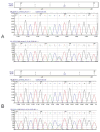Somatotroph pituitary adenoma with acromegaly and autosomal dominant polycystic kidney disease: SSTR5 polymorphism and PKD1 mutation
- PMID: 21744088
- PMCID: PMC3905832
- DOI: 10.1007/s11102-011-0325-0
Somatotroph pituitary adenoma with acromegaly and autosomal dominant polycystic kidney disease: SSTR5 polymorphism and PKD1 mutation
Abstract
A 39-year-old woman with autosomal dominant polycystic kidney disease (ADPKD) presented with acromegaly and a pituitary macroadenoma. There was a family history of this renal disorder. She had undergone surgery for pituitary adenoma 6 years prior. Physical examination disclosed bitemporal hemianopsia and elevation of both basal growth hormone (GH) 106 ng/mL (normal 0-5) and insulin-like growth factor (IGF-1) 811 ng/mL (normal 48-255) blood levels. A magnetic resonance imaging scan disclosed a 3.0 cm sellar and suprasellar mass with both optic chiasm compression and left cavernous sinus invasion. Pathologic, cytogenetic, molecular and in silico analysis was undertaken. Histologic, immunohistochemical and ultrastructural studies of the lesion disclosed a sparsely granulated somatotroph adenoma. Standard chromosome analysis on the blood sample showed no abnormality. Sequence analysis of the coding regions of PKD1 and PKD2 employing DNA from both peripheral leukocytes and the tumor revealed the most common PKD1 mutation, 5014_5015delAG. Analysis of the entire SSTR5 gene disclosed the variant c.142C>A (p.L48M, rs4988483) in the heterozygous state in both blood and tumor, while no pathogenic mutations were noted in the MEN1, AIP, p27Kip1 and SSTR2 genes. To our knowledge, this is the fourth reported case of a GH-producing pituitary adenoma associated with ADPKD, but the first subjected to extensive morphological, ultrastructural, cytogenetic and molecular studies. The physical proximity of the PKD1 and SSTR5 genes on chromosome 16 suggests a causal relationship between ADPKD and somatotroph adenoma.
Figures




Similar articles
-
AIP mutation identified in a patient with acromegaly caused by pituitary somatotroph adenoma with neuronal choristoma.Exp Clin Endocrinol Diabetes. 2013 May;121(5):295-9. doi: 10.1055/s-0032-1331697. Epub 2013 May 14. Exp Clin Endocrinol Diabetes. 2013. PMID: 23674160
-
Molecular and functional properties of densely and sparsely granulated GH-producing pituitary adenomas.Eur J Endocrinol. 2013 Sep 12;169(4):391-400. doi: 10.1530/EJE-13-0134. Print 2013 Oct. Eur J Endocrinol. 2013. PMID: 23847328
-
Impact of preoperative pasireotide therapy on invasive octreotide-resistant acromegaly.Endocr J. 2018 Oct 29;65(10):1061-1067. doi: 10.1507/endocrj.EJ17-0487. Epub 2018 Aug 4. Endocr J. 2018. PMID: 30078825
-
Genetic abnormalities of somatostatin receptors in pituitary tumors.Mol Cell Endocrinol. 2008 May 14;286(1-2):180-6. doi: 10.1016/j.mce.2007.08.013. Epub 2007 Aug 31. Mol Cell Endocrinol. 2008. PMID: 17913341 Review.
-
[Genetic screening for mutations enables early diagnosis of pituitary adenomas].Ugeskr Laeger. 2014 Jan 6;176(1):54-7. Ugeskr Laeger. 2014. PMID: 24629609 Review. Danish.
Cited by
-
Aryl hydrocarbon receptor interacting protein and syndromic gene variants detected in Turkish isolated pituitary adenoma families by whole exome sequencing.Sci Rep. 2025 Jul 7;15(1):24279. doi: 10.1038/s41598-025-08610-1. Sci Rep. 2025. PMID: 40624119 Free PMC article.
-
A differential diagnosis of inherited endocrine tumors and their tumor counterparts.Clinics (Sao Paulo). 2013 Jul;68(7):1039-56. doi: 10.6061/clinics/2013(07)24. Clinics (Sao Paulo). 2013. PMID: 23917672 Free PMC article. Review.
-
Reduction of polycystic kidney and liver volumes in a patient with tolvaptan-resistant autosomal dominant polycystic kidney disease and acromegaly during lanreotide therapy.CEN Case Rep. 2025 Jun 27. doi: 10.1007/s13730-025-01013-1. Online ahead of print. CEN Case Rep. 2025. PMID: 40579692
-
The Genetics of Pituitary Adenomas.J Clin Med. 2019 Dec 21;9(1):30. doi: 10.3390/jcm9010030. J Clin Med. 2019. PMID: 31877737 Free PMC article. Review.
-
Pituitary Adenoma: SSTR2 rs2236750, SSTR5 rs34037914, and AIP rs267606574 Genetic Variants, Serum Levels, and Ki-67 Labeling Index Associations.Medicina (Kaunas). 2024 Aug 1;60(8):1252. doi: 10.3390/medicina60081252. Medicina (Kaunas). 2024. PMID: 39202532 Free PMC article.
References
Publication types
MeSH terms
Substances
Grants and funding
LinkOut - more resources
Full Text Sources
Medical
Miscellaneous

